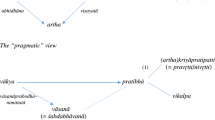Abstract
The two theories of verbal cognition, namely abhihitānvaya and anvitābhidhāna, first put forth by the Bhāṭṭa and Prābhākara Mīmāṃsakas respectively in the second half of the first millennium C.E., can be considered as being foundational as all subsequent thinkers of the Sanskritic intellectual tradition (philosophers as well as ālaṃkārikas) engaged with and elaborated upon these while debating the nature of language and meaning. In this paper, I focus on the first chapter (pariccheda) of Śālikanātha’s Vākyārthamātṛkā and outline the process of anvitābhidhāna described therein. Śālikanātha explains this as comprising three steps, and thereafter discusses each of these three to elaborate upon and philosophically defend this conception of how one cognizes sentential meaning. The aim of this paper is to present Śālikanātha’s three-step model, and thus demonstrate especially the distinct conception of abhidhāna (denotation) for the Prābhākara Mīmāṃsakas (particularly Śālikanātha) as complex and chronologically extended as contrasted with the Bhāṭṭa conception of abhidhāna as non-complex and instantaneous. Such an understanding of the disparate semantic contents with which the Bhāṭṭas and Prābhākaras use the identical term abhidhāna is crucial for any correct study of their respective doctrines.
Similar content being viewed by others
Abbreviations
- CoD:
-
Connection of Denoted [Meanings] (abhihitānvaya)
- DoC:
-
Denotation of Connected [Meanings] (anvitābhidhāna)
- KṬ:
-
Sucarita’s Kāśikāṭīkā on Ślokavārttika Vākyādhikaraṇa vv.110 cd-112ab
- PMS:
-
Jaimini’s Pūrvamīmāṃsāsūtra
- ŚBh:
-
Śābarabhāṣya
- SM:
-
Sentential meaning
- ŚV:
-
Kumārila’s Ślokavārttika
- ŚV Vāk.:
-
Ślokavārttika Vākyādhikaraṇa
- TV:
-
Kumārila’s Tantravārttika
- VM-I:
-
First chapter (pariccheda) of Śālikanātha’s Vākyārthamātṛkā
- WM:
-
Word-meaning
References
Primary Sources
Āpaṭe, Vināyaka Gaṇeśa, ed. 1929. Śrīmajjaiminipraṇīte Mīmāṃsādarśane. Vol. 1. 6 vol. Ānandāśramasaṃskṛtagranthāvaliḥ 97. Puṇya: Ānandāśramamudraṇālaya.
Kevalānandasaraswatī, ed. 1952. Mīmāṃsākośaḥ - Part I. Prājña Pāṭhashālā Maṇḍala Grantha Mālā.
Sastri, A.Subrahmanya, ed. 1964. Prakaraṇapañcikā of śālikanātha Miśra with the Nyāyasiddhi of Jaipuri Nārāyaṇa Bhatta. Banaras Hindu University (BHU) Darśana Series No. 4.
Sastri, Mukund, ed. 1904. Prakaraṇapañcikānāma Prabhākaramatānusāri Mīmāṃsādarśanam. Chowkhamba-Saṃskṛta-Granthamālā (Granthasaṃkhyā 17).
Secondary Sources
Apte, V.S. 1959. Three Prin. V. S. Apte’s The Practical Sanskrit-English Dictionary. Poona: Prasad Prakashan.
Chakrabarti, A. (1989). Sentence-holism, context-principle and connected-designation Anvitabhidhāna: Three doctrines or one? Journal of Indian Philosophy, 17(1), 37–41.
Clooney, F. X. (1990). Thinking Ritually: Rediscovering the Pūrva Mīmāṃsā of Jaimini. Publications of the de Nobili Research Library: 17. Vienna: Institut für Indologie der Universität Wien : Sammlung de Nobili.
Jha, G. (1933). Shabara-Bhāṣya—(Vol. I) (G. Jha Trans.) Gaekwad’s Oriental Series, No. 66, 70, 73. Baroda: Oriental Institute.
Kataoka, K. (2003). The Mīmāṃsā definition of Pramāṇa as a source of new information. Journal of Indian Philosophy, 31(1/3), 89–103.
Kataoka, K. (2011). Kumārila on truth, omniscience and killing—Part 2: An annotated translation of Mīmāṃsā-ślokavārttika Ad 1.1.2 (Codanāsūtra). Beiträge Zur Kultur- Und Geistesgeschichte Asiens 68. Wien: Verlag der Österreichischen Akademie der Wissenschaften.
Matilal, B. K., & Sen, P. K. (1988). The Context Principle and Some Indian Controversies over Meaning. Mind, 97(385), 73–97.
McCrea, L. (2000). The hierarchical organization of language in Mīmāṃsā interpretive theory. Journal of Indian Philosophy, 28(5), 429–459.
McCrea, L. (n.d.) Kumārila on the role of implicature (lakṣaṇā) in sentence meaning. In A. Graheli (Ed.), The Bloomsbury Handbook of Indian Philosophy of Language. London.
Monier-Williams, M. (1899). A Sanskrit-English Dictionary: Etymologically and philologically arranged with special references to cognate Indo-European languages. Oxford: Clarendon Press.
Raja, K. K. (1969). Indian theories of meaning. Adyar Library Series. Adyar Library; Research Centre.
Saxena, S. (2018). Linguistic and phenomenological theories of verbal cognition in Mīmāṃsā: A study of the arguments in Śālikanātha’s Vākyārthamātṛkā-I and the response in Sucarita’s Kāśikāṭīkā. PhD Thesis, University of Cambridge. https://www.repository.cam.ac.uk/handle/1810/289760.
Taber, J. (1989). The theory of the sentence in Pūrva Mīmāṃsā and Western Philosophy. Journal of Indian Philosophy, 17(4), 407–430.
Thibaut, G., ed. (1882). The Arthasaṃgraha: An elementary treatise on Mīmāṃsā by Laugākshi Bhāskara. (G. Thibaut Trans). Chaukhamba Amarabharati Studies. Braj B. Das; Co.
Author information
Authors and Affiliations
Corresponding author
Ethics declarations
Conflict of interest
The author declares that there is no conflict of interest.
Additional information
Publisher's Note
Springer Nature remains neutral with regard to jurisdictional claims in published maps and institutional affiliations.
Rights and permissions
About this article
Cite this article
Saxena, S. Denotation as Complex and Chronologically Extended: anvitābhidhāna in Śālikanātha’s Vākyārthamātṛkā-I. J Indian Philos 47, 489–506 (2019). https://doi.org/10.1007/s10781-019-09394-1
Published:
Issue Date:
DOI: https://doi.org/10.1007/s10781-019-09394-1



